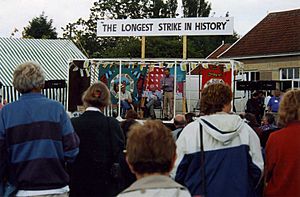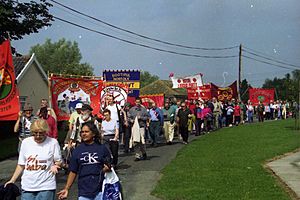Burston Strike School facts for kids
Quick facts for kids Burston Strike School |
|
|---|---|
 |
|
| Information | |
| Established | 1914 |
| Founders | Annie Higdon Tom Higdon |
| Closed | 1939 |
The Burston Strike School was a special school started by children and their teachers. It began because of a school strike in the village of Burston, England. This strike lasted for a very long time, from 1914 to 1939, making it the longest strike in British history. Today, the old school building is a museum. Every year, many people gather there to remember the 25-year strike led by teachers Annie and Tom Higdon.
Contents
The Strike School's Story
The strike started when Annie Higdon and her husband, Tom Higdon, who were teachers at the village's Church of England school, were fired. This happened after they had disagreements with the people managing the school. The students, led by a girl named Violet Potter, went on strike to support their teachers.
With encouragement from the community, the Higdons decided to open their own school. At first, 66 out of their 72 former students joined them. The school began in a large tent on the village green. Later, it moved to a local carpenter's building. Eventually, a new school building was built with money donated by groups that supported workers. The Burston Strike School continued teaching local children until shortly after Tom Higdon passed away in 1939.
Why the Strike Happened
Teachers' Early Life
Annie Katherine Schollick, known as Kitty, married Tom Higdon in 1896. They first lived in London. In 1902, they moved to Wood Dalling in Norfolk. Around this time, a new law called the Education Bill was being discussed. This law aimed to provide education for children from working-class families.
Problems at Wood Dalling
Kitty became the headmistress at Wood Dalling School, and Tom was an assistant teacher. They felt connected to the local farm workers. This caused problems with the school managers, who were mostly farmers. The Higdons complained about the school's cold and unhealthy conditions. They especially protested when farmers took children out of school to work on their land. Because of these issues, the Norfolk Education Committee told the Higdons they could either be fired or move to another school. They chose to move and arrived at Burston School in 1911.
Challenges in Burston
In Burston, the Higdons found similar problems. The new rector, Reverend Charles Tucker Eland, became the chairman of the School Managing Body. He wanted to regain power for the Church in the community. The rector earned a good salary and lived in a large house. This was very different from the farm workers and their families, who earned much less and lived in poor cottages. The farmers, who employed these workers, usually sided with the rector.
Higdons Stand Up for Workers
In 1913, Tom Higdon helped organize local farm workers. He successfully ran for election to the parish council, getting the most votes. Reverend Eland, who expected to win, was not elected. Even though the rector and farmers lost in the council election, they still controlled the school. They decided to use this power against the Higdons.
Since arriving in Burston, the Higdons had complained about the school's conditions. They pointed out the dampness, poor heating and lighting, and lack of fresh air. The managers looked for a reason to act against them. They accused Kitty of lighting a fire without permission to dry the clothes of children who had walked far in the rain. She was also accused of being rude when questioned about this. Additionally, Kitty was accused of being unfair to two children from a charity. Despite her beliefs against violence, the school managers said there was "good reason" for the complaints. They demanded the Higdons be moved to another school.
Tom and Kitty asked for an investigation by the local education committee. Kitty was sick and could not attend. The lawyer from the National Union of Teachers did not call any witnesses to defend her. Still, the accusation of being unfair to the children was not proven. Only the accusation of being rude to the managers was accepted. This was enough to give the Higdons three months' notice to leave their jobs.
The Strike School's Journey
Children Take Action
The Higdons' dismissal became official on April 1, 1914. As the authorities arrived, children could be heard marching and singing. Out of 72 students, 66 went on strike, marching around the village with flags. None of them went back to the old school. Instead, they had lessons on the village green. This new "school" had good equipment, a full schedule, and kept attendance records. Parents fully supported it.
The authorities did not like this defiance. They took 18 parents to court and fined them for not sending their children to the official school. However, people collected money outside the court to pay the fines. Since parents were sending their children to the school they chose, the authorities soon had to give up.
Growing Support and Challenges
News of the strike quickly spread. It became an important issue for workers' unions and people who wanted to improve schools across the country. Supporters and speakers visited regularly. When winter came, the school moved into empty workshops.
The authorities continued to try and stop the strike. Farmers fired workers who supported the Higdons, which also meant they lost their homes. But this didn't last long. During the First World War, there weren't enough workers, so the fired labourers had to be hired back. Families who rented land from the rector for growing food were evicted, and their crops were destroyed. The village's Methodist preacher, who held services for the strike school families, was criticized by his church.
A New School Building
At the end of the first year of the strike, the lease on the old workshops was ending. An appeal was made to raise money for a new school building. By 1917, a national fundraising effort had collected £1,250. Donations came from miners' and railway workers' unions, Trades councils, political groups like the Independent Labour Party, and Co-operative Societies. The new school officially opened on May 13, 1917. Violet Potter, who led the first student protest in 1914, declared, "With joy and thankfulness I declare this school open to be forever a School of Freedom."
The Burston Strike School continued until 1939. Tom Higdon passed away on August 16, 1939. By then, Kitty, who was in her seventies, could not continue alone. The last eleven students moved to the local council's school. Kitty moved to a nursing home and passed away on April 24, 1946. They are buried next to each other in Burston churchyard, near the Strike School building.
What Happened Later

In 1949, a union called the National Union of Agricultural Workers (NUAW) helped make The Burston Strike School a registered charity for education. Along with Sol Sandy, a remaining trustee and NUAW member, three more trustees from the union were appointed. These trustees are legally responsible for managing the school. They work to make it a museum, a place for visitors, an educational archive, and a community space.
In the early 1980s, the NUAW joined with another union, the Transport and General Workers' Union (TGWU). Around that time, the Strike School was turned into a museum. An annual rally to remember the school and the longest strike in UK history was restarted. This rally has been held on the first Sunday in September every year since 1984. It is organized by the trustees and members of TGWU (now Unite the Union), with help from other union groups.
Stories and Films
Television Show
The story of the strike was made into a TV show by the BBC in 1985. The show, called Screen Two: The Burston Rebellion, was written by Elaine Morgan. It starred Eileen Atkins as Kitty Higdon, Bernard Hill as Tom Higdon, John Shrapnel as Reverend Charles Tucker Eland, and Nicola Cowper as Violet Potter. It was shown on February 24, 1985, after a documentary about the strike aired the day before.
Movie Plans
In 2015, it was announced that a movie about the strike would be made. It was planned for release in 2017, titled Burston. The filmmakers aimed to shoot the movie in summer 2017 for a 2018 release. However, filming stopped in 2017. The movie was to be directed by George Moore, who grew up in Norfolk, with a script by Alice Instone-Brewer. The cast included Jasmine Fretwell as Violet Potter, Niklass van Poorvleit as Tom Higdon, and Robert Clement-Evans as Rev. Eland. The filmmakers were reportedly working closely with the Burston Strike School Museum to make sure the movie was accurate. They also hired many cast and crew members from Norfolk to reflect the story's local roots.
See also
- School strikes of 1911 in the United Kingdom


